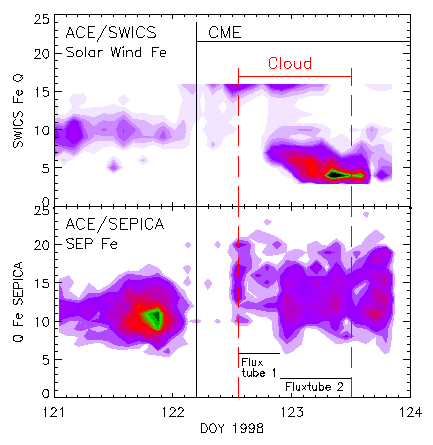
| ACE News Archives | ACE News #50 - October 25, 2000 |
ACE News Archives |

Optical measurements of solar activity and previous in-situ plasma measurements at one AU have led to the separate characterization of solar ejecta at the Sun and near the Earth. The transport from Sun to Earth, however, is not completely understood. Charge states of solar energetic particles (SEPs) and solar wind plasma are excellent tracers for the conditions in the source region and thus can help close this gap. This is demonstrated in one particularly interesting example.
An important type of coronal mass ejection observed in situ is a magnetic cloud that contains a well-organized, twisted magnetic flux tube. The cloud can have at least one footpoint connected to an active region on the Sun. Very rarely, there is also very dense and cold matter trailing the cloud. Such a cloud was observed on ACE on May 2-3, 1998. Iron charge state measurements were performed, as shown above, by solar wind (ACE/SWICS) and energetic particle (ACE/SEPICA) instruments. The lines in the figure indicating the boundaries of the CME and cloud were drawn from measurements by the ACE/MAG and ACESWEPAM instruments. Unexpectedly, in spite of a considerable difference in energy, 200 keV/nuc vs. 1 keV/nuc, iron populations with similar charge state signatures were observed in both instruments. The temporal profile suggests that the spacecraft crossed two flux tubes within the cloud. The first flux tube contained high charge state iron, and the second contained much colder material.
The high charge state iron in the solar wind originated in the active region from which the cloud erupted three days before. The cold solar wind plasma was clearly associated with an erupting prominence that was observed at that time by SOHO. The active region then moved across the solar disk as the Sun rotated, and erupted again on May 2 at W07, near disk center. This eruption was located using X-ray observations from Yohkoh. SEPs from this longitude are not likely to reach the Earth, however a cloud may act as a channel, magnetically confining SEPs that enter at its footpoint. The SEPs observed on May 2 within the cloud at 1 AU had a 7 hour travel time from the Sun, which was consistent with the time of eruption. These simultaneous solar wind and SEP observations have helped characterize the structure within the cloud and demonstrated that the cloud was still magnetically connected to the active region from which it originated 3 days before. In addition, by linking both particle populations to the same source, they provide clues to the relationship between the SEPs and solar wind in active regions.
Contributed by Mark Popecki of the University of New Hampshire and Thomas Zurbuchen of the University of Michigan.
For more information on the SEPICA and SWICS instruments, see The SEPICA Home Page and The SWICS Home Page.
Last modified 26 October 2000, by
Andrew Davis